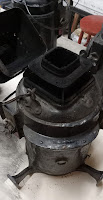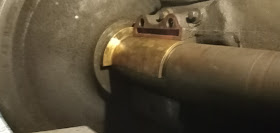The first task on Wednesday was to put the original bearing back together on the 309 so it can be moved over the pit at some point. On Sunday the heavy motor cap was lifted onto the platform, and after some effort I was able to get the two halves in place on the axle, as seen here:
Thursday, August 31, 2023
Wednesday Brief
Wednesday, August 30, 2023
Keep Your Lamps Trimmed and Burning
Since we're going to be having operations after dark on both Labor Day and Member's Day weekends, it's time for another exciting aspect of historical accuracy: oil-fired lanterns and marker lights!
Railroading started, of course, long before the invention of the electric light bulb, and oil lamps continued to be used for hand lanterns, switch stands, signals, and so on for many years afterwards because they were much more reliable. It's impossible to predict when a battery is going to die or a light bulb will burn out. But as long as you have an easily-checked supply of fuel, wicks, and matches, you can keep an oil lamp burning forever. With modern technology, of course, electric lights are so reliable that no one on the railroads would think of going back to the hassle of maintaining oil lamps -- except us.
Luckily we have a good supply of authentic marker lights for use on our interurban cars, as seen here. These are Adlake marker lamps designed to fit the brackets installed at each end of the cars. (I also have an IC hand lantern that belonged to my uncle's father-in-law.) Each marker has two Fresnel lenses, and each lens has two movable color filters, red and green. Thus each light can show either white, red, or green. Some of the mechanisms for moving the filters are jammed, however, but I have it arranged so each lamp shows red on one side and white on the other. That's all we'll need for our operation.
 |
| Color filter control |
 |
| The top is hinged. The chimney is in two parts, easily removable. |
Tuesday, August 29, 2023
Line Car Report
Gregg Wolfersheim reports on recent progress on Illinois Terminal line car 1702:
Several weeks ago the roof of the line car was painted to
seal it up.
And then, suddenly, the four lift posts disappeared. This will make it easier to apply the canvas.
The canvas was spread out on some pavement and thoroughly washed.
This past Sunday a system was designed and built to start stretching the canvas.
Here is the other end slowly coming up to the edge. Hopefully in another week it will extend past the edge. Then we'll be ready to start tacking it down.
Monday, August 28, 2023
Them's the Brakes
Following a successful test trip we put the 18 back in Barn 7 and headed to dinner. After dinner, I put some white primer on the bare metal (and bare Bondo) spots on the last unpainted section of the left side of the car below the belt rail.
The last unpainted section of the right side of the car below the belt rail, the panel in between the doors, also got white primer. Before heading home, I was also able to create a temporary bell cord hanger using a strip of leather. The 18 has been missing the hanger located over the conductor's station since we got the car; the loop that the bell cord passes through came with the car but not the fixture that attaches to the ceiling, so we'll need to find a replacement for that. In the meantime, I rigged up a temporary hanger, so now the conductor can signal the motorman. Thanks to Jimmy and Bill for removing the loop casting and to Matthew for helping install the new hanger.
So what else was happening? A few of the regulars were out of town (and, in some cases, out of the country) but when I first arrived the loop at Electric Park was veritably strewn with buses.
It turns out that this week, the Hoffman Bus Garage will be getting lights for the first time since it was built about two decades ago. So that's exciting. Here, you can see a demonstration of how you "switch" buses, with Richard in the backhoe and Steven at the wheel of our North Shore ACF bus.
Here's another view of the ACF bus. This is a neat piece, I'll admit, and a good candidate for turn-key off-site restoration (hint, hint to you North Shore fans). The bus guys recently sent out most, or maybe all, of the windows from this bus for re-glazing.
Sunday, August 27, 2023
Saturday Operations
It's now just a week until Labor Day Weekend. A lot will be happening over the weekend, which you can read all about on the IRM website, but in particular we'll be running the CA&E wood cars on Saturday evening until about 10 PM. You won't want to miss it -- nighttime operations are always a blast. I spent some time on Saturday getting things ready, checking the oil, and so on. Nothing much to take a picture of. But several other things were going on, as always:
In one of many current B&G projects, a new (antique) traffic signal is being installed on the northwest corner of Depot and Central, just like the one on the southeast corner.
Monday, August 21, 2023
Beat the Heat
Tuesday, August 15, 2023
Quick Visit to Oregon
It's been several years since I last visited Oregon, so I took the opportunity to stop in briefly on a recent road trip. Unfortunately, on a Monday morning there was no one around, and the depot was closed. It still looks nice, of course, and the local preservation group keeps it open on weekends.
But as usual, there's no place like home!
Monday, August 14, 2023
Second Coat
Sorry for the fuzzy pictures. This second coat makes a big difference. We have enough paint for a third coat, so I want to put that on, and then we'll bring the car outside and see how it looks. I also did a little more sanding on the sides; small areas on both the left and right sides still need grey paint below the belt rail, but the exterior repaint continues chugging along.
In other news, Zach brought out swatches of custom-made seat fabric that he was able to procure. One was for North Shore "diamond pattern" green plush while the other, shown here at the top, is the type of material used on the CA&E 450-series cars. It looks striped but it's really all the same color, just cut differently row by row - some looped over and some "shaved" off. We agreed that the color and "look" was about perfect (the original sample visible at the bottom of the frame is obviously worn and faded). The spacing is ever-so-slightly wider than original, and there is a bit too much of a "hill and dale" texture to the rows, so we'll ask the manufacturer about that. But watch this space for news on a potential project to reupholster the seats in one or more of the 450s.
In other news, there was a lot going on. Gregg was working on the 1702, and hopefully we'll soon have a more comprehensive update, but here you can see canvas hanging off the roof. So that's exciting! Doodlebug Bob was working on machining another armature for a DB-160 contactor for the 1565, while Norm and Zach were working on chasing down electrical gremlins in the Electroliner.
I also noticed that Frank, Mike, and Steve installed the first set of original-type blinker doors on our Kansas City PCC. I'm not sure whether these doors are permanently installed or whether this is a test installation, but this will certainly make a big difference in the car's appearance. The Philadelphia-area plywood doors, like what's to the left, make for quite a contrast.
Sunday, August 13, 2023
309 Bearing Update
A couple of steps were required to prepare the new bearing castings:
The edges that were soldered need to be filed flat. Also flashings on the drilled holes need to be filed off. That wasn't too hard.



















































